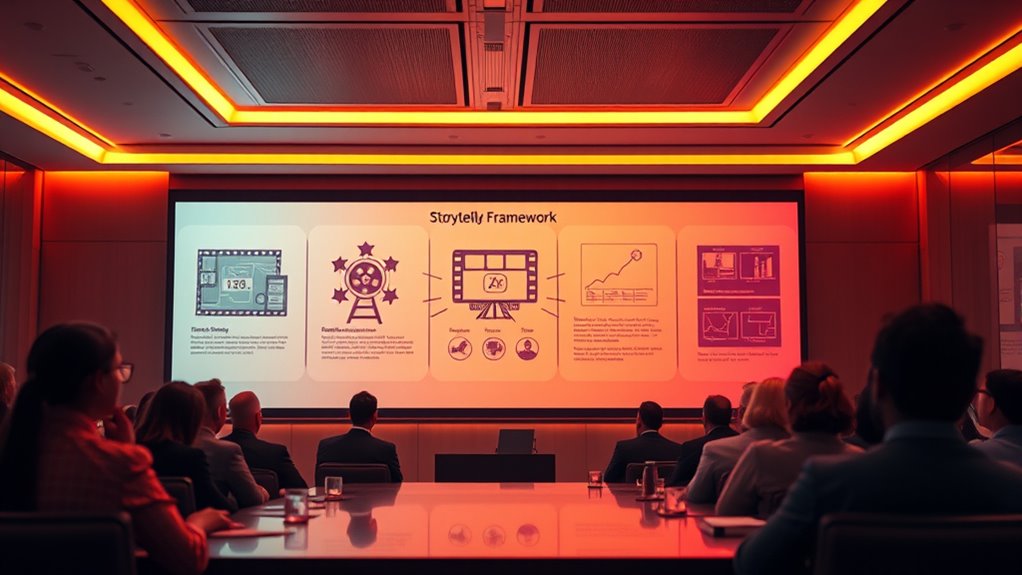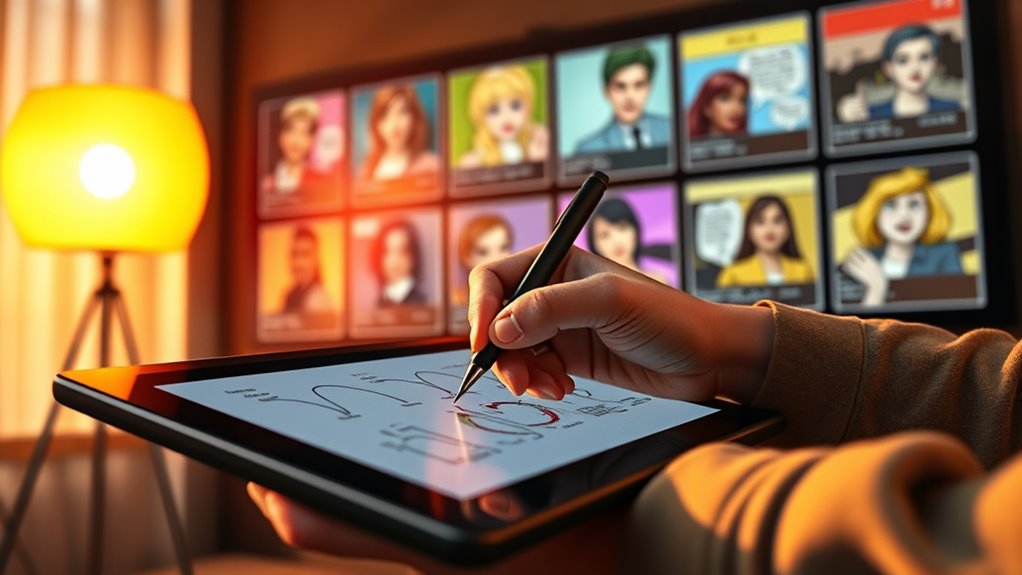Designers often borrow Hollywood storytelling frameworks to create engaging visuals. The Three-Act Structure helps you organize your story with a compelling beginning, middle, and end. The Hero’s Journey inspires relatable characters facing challenges and transforming. The Montage Technique condenses time, showing progress quickly. Building tension through pacing keeps your audience invested and enthusiastic for more. Strong character development fosters emotional connections. Keep exploring these techniques to master storytelling that captivates every viewer.
Key Takeaways
- The Three-Act Structure provides a clear narrative arc for engaging, organized storytelling.
- The Hero’s Journey offers universal patterns of transformation that resonate emotionally with audiences.
- The Montage Technique condenses time and highlights key moments efficiently through combined visuals and music.
- Building tension through pacing manipulates emotional responses, creating suspense and engagement.
- Character Development emphasizes authentic, relatable characters to foster empathy and emotional investment.
The Three-Act Structure

Have you ever wondered why many stories feel so satisfying and well-organized? That’s often due to the three-act structure, a classic storytelling framework. It guides your story with clear narrative arcs, creating a seamless flow from beginning to end. Using visual storytelling techniques, you can map out the setup, confrontation, and resolution, ensuring each act builds on the last. Act 1 introduces your characters and setting, grabbing your audience’s attention. Act 2 develops conflict and heightens tension, keeping viewers engaged. Act 3 delivers the payoff, resolving key storylines. This structure helps you craft compelling, easy-to-follow stories that resonate. By understanding the three-act structure, you create a strong foundation for your narrative, making your storytelling both effective and memorable. Incorporating elements like the storytelling framework can enhance viewer engagement and emotional impact.
The Hero’s Journey

Ever wonder why certain stories resonate so deeply across cultures? The Hero’s Journey is a powerful framework that taps into universal narrative arcs. It guides you through a hero who faces challenges, transforms, and returns wiser. This structure enhances visual storytelling by creating relatable, compelling characters and clear emotional beats. You can use it to craft stories that feel authentic and engaging, connecting audiences on a deep level. By following the hero’s path—call to adventure, trials, revelation—you shape your story’s rhythm and impact. This framework provides a blueprint for meaningful storytelling, ensuring your narrative arcs resonate universally. When you understand this process, you can craft stories that inspire, motivate, and stay with your audience long after they’ve finished watching. Storytelling frameworks like the Hero’s Journey help structure narratives that are both memorable and impactful.
The Montage Technique

The montage technique is a dynamic storytelling tool that condenses time and space, allowing you to show a series of events quickly and efficiently. By combining visuals, music, and editing, you create a powerful sequence that captures progression or transformation without lengthy scenes. This approach enhances visual storytelling, making complex ideas or emotional shifts more immediate and engaging. When executed well, montages evoke emotional resonance, helping your audience feel the passage of time or the evolution of a character’s journey. Instead of slow, detailed explanations, you rely on imagery and rhythm to communicate meaning. This technique keeps your story moving, maintaining energy and focus while delivering a rich emotional impact through concise, compelling visual snippets. Incorporating visual storytelling techniques, such as montages, can amplify your narrative’s effectiveness and audience engagement.
Building Tension Through Pacing

After mastering the montage to convey rapid changes, the next step is controlling how your story unfolds moment by moment. You do this through visual pacing, adjusting the rhythm of scenes and shots to build tension. Short, quick cuts increase pace and heighten emotional escalation, making viewers feel anxious or excited. Conversely, lingering shots slow down the story, giving your audience space to process and anticipate what’s coming. By strategically varying pacing, you guide emotional responses, creating suspense or relief exactly when needed. Pacing isn’t just about speed; it’s about sculpting the story’s emotional rhythm, keeping your audience engaged and enthusiastic for the next development. Understanding anime film storytelling helps you incorporate effective pacing techniques used in acclaimed movies, transforming a simple story into an immersive, emotionally charged experience.
Character Development and Relatability

How do you make your audience truly care about your story? It all comes down to character development and relatability. When your characters feel authentic, they create emotional resonance that draws viewers in. You want your audience to see themselves in your characters, fostering genuine empathy. Show their flaws, desires, and struggles honestly—these details make them more human. When characters evolve in believable ways, viewers become invested in their journeys. This process is supported by positive thinking, which encourages a growth mindset and resilience in characters, making their development even more compelling. This connection fuels audience empathy, making every triumph or setback feel personal. By crafting characters with depth and authenticity, you transform your story into an experience that resonates deeply. Ultimately, relatable characters turn passive viewers into active participants, making your story memorable long after the credits roll.
Frequently Asked Questions
How Can These Frameworks Be Adapted for Digital and Interactive Designs?
You can adapt storytelling frameworks for digital and interactive designs by focusing on creating engaging interactive narratives and immersive storytelling experiences. Use techniques like branching storylines and real-time feedback to make users feel involved. Incorporate multimedia elements such as videos, animations, and sound to enhance immersion. By applying these frameworks thoughtfully, you’ll craft compelling digital stories that captivate your audience and deepen their engagement through interactive and immersive storytelling.
What Are Common Mistakes When Applying Hollywood Storytelling Techniques?
Imagine weaving a story, only to fall into cultural misinterpretations or oversimplified narratives that disconnect your audience. When applying Hollywood storytelling techniques, you might overlook cultural nuances, leading to miscommunication. You could also rely too heavily on clichés, making your story predictable. Avoid these mistakes by understanding your audience deeply, respecting diverse perspectives, and tailoring your narrative to resonate authentically, ensuring your storytelling remains compelling and meaningful.
How Do Cultural Differences Influence Storytelling Frameworks in Design?
You should recognize that cultural nuances deeply influence storytelling frameworks in design, shaping how audiences interpret narratives. While storytelling has universality, different cultures emphasize unique themes, symbols, and structures that resonate locally. When designing, you adapt your storytelling to respect these cultural differences, ensuring your message remains authentic and engaging across diverse audiences. Ignoring cultural nuances risks miscommunication, but embracing them enriches your storytelling’s impact and relevance globally.
Can These Frameworks Be Used for Non-Narrative Design Projects?
Think of storytelling frameworks as Swiss Army knives—they’re versatile tools, not just for narratives. You can definitely use them for non-narrative design projects, as their core principles promote engagement and clarity. The key is to focus on narrative applicability and adapt the frameworks creatively. With some design adaptation, you’ll find these storytelling strategies can enhance user experience, making your projects more compelling, even without a traditional story structure.
How Do These Storytelling Methods Impact User Engagement and Retention?
You’ll find that storytelling methods boost user engagement and retention by creating emotional resonance and cognitive engagement. When you craft narratives that connect on an emotional level, users feel more invested and motivated to stay. These frameworks guide you to design experiences that evoke feelings and stimulate thoughts, making users more likely to return. Overall, storytelling elevates your project’s ability to build strong, lasting connections with your audience.
Conclusion
By mastering these Hollywood storytelling frameworks, you craft stories that captivate, engage, and resonate. You build tension through pacing, develop characters that feel real, and structure your narrative with clarity. You borrow the three-act rhythm, embrace the hero’s journey, and use montage techniques to evoke emotion. You create experiences that stick. With these tools, you elevate your designs, connect deeply with your audience, and turn your ideas into unforgettable stories.









